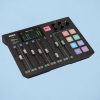
Review: Shure MV7i
Shure builds a two-channel preamp and interface into its popular MV7.
Shure has been a major player in the broadcast sector for a very long time. By incorporating recent advances in digital technology to complement their long-standing pedigree in dynamic microphone design, it’s no surprise the company has recently had great success in the areas of podcasting, live streaming, gaming and mobile digital broadcasting as well. Shure’s new offering, the MV7i, is the latest in its very popular MV7 line and it has a significant new trick up its sleeve. While the new mic is almost identical in size and appearance to previous MV7 series models, it houses an additional mic preamp and digital audio interface to offer users an extremely compact all-in-one two-channel recording and broadcasting solution.
DOUBLE THREAT
Microphones with built-in interfaces have been around for a while now, but Shure is certainly breaking new ground here by integrating high-quality recording, versatile digital control and dual-channel flexibility in a one-mic form factor. The MV7i incorporates all this technology very impressively, while the overall package of hardware and software delivers on a number of fronts. Firstly, the MV7i is easy to set up and use – I was up and running within 10 minutes of taking it out of the box. Downloading the software was quick and painless, and after plugging in the included three-metre USB-C cable I was ready to get to work. The Motiv Mix software accompanying the mic is also very user friendly, intuitive and quick to learn and work with. Secondly, the sound is great – Shure’s acumen in this area is second-to-none, with the ubiquitous SM7/SM7b form factor and electronic design clearly paving the way for the new mic. Thirdly, the addition of a second mic or line input source that plugs directly into the mic/interface greatly increases the applications available to any content creator while eliminating the need for a separate interface. With the MV7i, if you have a second mic or line input source, a cable to connect it, a set of headphones and a digital device of some sort (phone, tablet or computer)… well, then, you’re in dual-channel business. Obvious scenarios here are dual presenter or interview formats, voice plus environmental capture, commentary over stereo audio, and of course singer plus instrument or multiple instrument recording. The concept sounds simple, and in practice it mostly is, so let’s have a look at how Shure makes this all work in more detail.
Shure is certainly breaking new ground here by integrating high-quality recording, versatile digital control and dual-channel flexibility in a one-mic form factor
FORM FACTOR
The MV7i ships with a USB-C cable, a quick start guide and… that’s it! This is practical acknowledgement of how streamlined a package this is, making its capabilities all the more impressive. A lightweight hard case would have been a good addition for users on the move but that would have added to the price tag and there are plenty of third-party solutions around. The mic itself incorporates a yoke that attaches directly to a standard mic stand thread and immediately brings to mind any number of broadcast studio setups. The yoke is easily adjusted via captive bolts on either side and the size of the mic belies the preamp and interface electronics tucked away inside.
Visually the mic reads as an updated version of the aforementioned SM7 with a familiar look to the mic’s shape and long, tapered foam windshield. However, taking the windshield off reveals quite a different-looking capsule housing, with a conventional steel grille offering sturdy protection against bumps and drops. The coloured LED meter strip that runs across one half of the mic’s collar is visually striking and marks the mic out as a very modern iteration. This clear and colourful LED serves several purposes at once, acting as a kind of level meter (it reacts to higher incoming signal with increased brightness) and also displaying one or both channels mute status. Speaking of which, the LED strip incorporates touch control of the mute functions, so you can (gently) touch the strip on either side to mute individual channels – a handy feature which gives operators easy mute control without having to reach for other devices. Operational modes and choice of colours for these functions can be customised in the Motiv Mix software.
Around the back the SM7i reveals its true identity as an audio interface, with a USB-C port cosying up to a minijack headphone output and a multi-function XLR/TRS 1/4-inch socket (48V phantom power is switchable via the software). The connections here are tightly packed but easily managed with the proviso that users need to carefully arrange their cable runs to avoid headphone tangles or mic droop issues. The overall build quality is excellent and the MV7i has a pro look that would be equally at home in smaller mobile setups, podcasting rooms and high-end broadcasting facilities. Speaking of which, the MV7i can operate at sample rates up to 32-bit/48k which will please even the most demanding post production supervisor. It should be noted that the MV7i microphone is USB only, meaning it cannot be used in the traditional way with external preamps. The onboard XLR is for a second mic input only.
Performance-wise the MV7i has a strong, well-balanced sound with excellent rejection of room reflections and extraneous noises. It deals with both speech and singing extremely well and, thanks to its flattering proximity effect, it can lend a real authority to anything that passes through it. The signal-to-noise and distortion specs are excellent and the MV7i’s sound is robust, detailed, without being harsh, and extremely well suited to the kinds of sources it is designed to capture.
NEED TO KNOW
Shure MV7i
Smart Microphone & Interface


MOTIV & MEANS
While the hardware part of the MV7i package is simple and compact the Motiv Mix-driven companion hardware packs a surprising number of features into a relatively simple two-page GUI. Motiv Mix integrates quickly and easily with PC and Mac desktops, tablets and smart phones allowing for numerous fixed or mobile content creation configurations and the software is well laid-out and simple to use. When capturing audio the first thing to consider is what Audio Output Mode you want to run with. ‘Mixdown’ presents an integrated mono version, Multi-Track keeps the two sources separate as two mono files, and Stereo is useful when combining mic input with a stereo signal from the 1/4-inch TRS source. With the latter two options, the software will give you output mixes of the combined signals as well as the individual sources.
The main Mixer page is divided into several sections. An input source selection pane lets you drag and drop sources (up to a maximum of five), and a ‘Soundcheck’ button automatically optimises input levels after it assesses a 10-second sample of the material to be recorded. There’s a mono or dual-channel input display that includes metering, level control, mute and monitoring selection. Separate monitor and output panes with dropdown menus provide plenty of options for output routing depending on what device you’re plugged into. When you click on the small blue cog icons at the bottom of the panes further Device Settings are accessed and this is where you can really customise your set-up to best suit the incoming source material.
On the input pane the Device Settings include options for the Mic and second Input as well as Global ones. Mic mode offers three different basic templates for incoming signal: speech, singing and instrument. Within these there’s a range of tools, including simple compression, limiting, EQ, reverb and real-time digital denoising and plosive suppression that are very effective. A two-step high-pass filter is another very handy feature and a SmartGate can be engaged to keep background noise at bay in speech mode. Globally there’s comprehensive level control for all input signals as well as playback level, reverb type and intensity plus control of the operating behaviours of the mic’s LED strip. The tools here sound good and do a great job of handling common audio problems while also offering a few useful enhancements. My only small gripe is the lack of control over reverb decay time. The verbs sound pretty good but they are all long and a shorter option or two would have been welcome.
STAYING ON TRACK
Motiv Mix’s other main page is called Library and this is where you access and review all previously recorded audio. This page is very straight-forward and allows review and audition of both individual and mixed files. Somewhat surprisingly, Library offers no way to label, rename or edit tracks. Neither can you do further mix work on multiple tracks after capture in Motiv Mix. The software is very much a ‘front-end’ orientated system that allows users to optimise incoming sounds in a variety of ways and does a great job of this while keeping things simple. The ethos of the MV7i and its software definitely encourages users to prepare and pre-mix their audio so that there will be no need for further processing. In a familiar environment where the mic and secondary source are set and you’ve customised your sounds to your liking, you’ll be ready to stream live or deliver the outputted tracks straight out of the Library folder. Having said that, for on-the-fly mobile work in untested environments or for higher-end broadcast requirements, some third-party post-production software would be a good adjunct to the tools Motiv Mix offers. One other feature I would like to see is the ability to save customised input settings as presets, something that would be extremely handy for users who bounce between a few different types of projects.

SHURE THING
To finish up my testing of the MV7i I set up a vocal plus instrument session, singing into the main mic and using a trusty Shure SM57 for acoustic guitar (one of my favourites). Again, it only took a few minutes to pull a good mix of voice and guitar while monitoring through the headphone minijack output. After a bit of experimenting with compression, the high-pass filter and EQ I was able to pull a great vocal sound while the available gain and signal-to-noise ratio of the built-in second preamp handled the SM57 (a relatively low output mic) with no problems at all. Recording in Multi-Track mode allowed me to output both a mono mix and separate tracks of both sources and listening back to the files through my studio speakers I was impressed with the results. It really is a streamlined process and I found the flexibility of the MV7i, combined with its great sound, to be a fun way to work.
I think Shure is onto a winner. Dual-channel capture or streaming without the need for an additional interface will appeal to a wide range of users, from podcasters to gamers to musicians on the move. As well as covering off all the more conventional broadcasting applications, the capacity to use your phone to live stream an interview from your friend’s sofa or capture a vocal and guitar idea in a hotel room in high quality, makes the MV7i a very attractive prospect indeed. You can set it up and pack it away in a few minutes and still have time for a proper lunch break! With the Motiv Mix software Shure has also struck a good balance between offering genuinely effective audio tools and keeping the less tech savvy user onboard. If you’re in the market for a versatile and high-quality two-channel audio solution, the MV7i will be hard to beat, both for its compact size and excellent sonic performance.
























RESPONSES